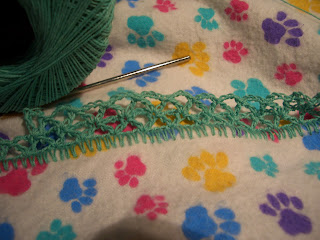Approaching 56 assembled granny squares, I was able to see the size of the finished product.
 |
| A bit of the border on the left side of the foto. |
Yikes! It's not as big as I hoped.
And I know you're thinking "It's her gauge." Nope. It's just desigend to be a lapghan. I sure wish I'd noticed that fact. What is it about my excitement at new projects that creates such barriers to the fine print? One of my many human weaknesses . . .
It's too small.
I do NOT wanna make any more granny squares than I have already.
Implications? Gotta create a border, and not just the several rows of sc called for as a finishing edge.
This implication and its many possible solutions sent me right over the edge. Even kept me awake! And certainly sent me to several resources to discover others' ideas. (I like Ravelry for this purpose, as well as images on Google that show up attached to a search.)
I settled on the simplest of all solutions, relying again on
Occam's Razor which says something about the simple answer usually being the best one. The border will be one row of beige sc to set a good foundation; then rows/rounds of granny 3-somes, with each row in one of the many colors used in the squares. I can use this method to expand the size of the afghan and may even intersperse a row or two more of the beige/oatmeal.
Remember that excitement I mentioned above? Yup, I needed to see the idea as a reality and right now! Never mind there are 10-12 squares left to finish. Nope, gonna skip right over that (even if temporarily) and proceed to the border.
 |
Here you can see that I'm adding squares around
the outside edge. I can insert the others after I
get a few rows of the border completed. |
I really like this pattern. It's a granny but with a bit of a twist. You can find the pattern at
Red Heart -- Versatile Afghan. My yarn was actually intended for another project -- but it surely won't surprise you that I grabbed it for this project. All of the yarn is
Bernat, Super Value.
Here's a few pix that will show you how the granny square is turned so that the corners are re-located 90 degrees to the right.
- The yellow center has one round of 'normal' granny corners.
- Then the purple round is begun, not in the green corner, but in the 1ch space between the corners.
- Double trebles are used to create a new corner, with ch3 between, passing over the green corner.
- The first of 2 final rounds uses the new corner. When it's time for a 3-some of DC to get to the next corner, you reach down to the green corner and capture it with the ch3 purple.
Lots of yarn, lots of color changes, lots of ends to weave. Organization is essential. If you've done a granny (or any project with lots of colors) you know how important it is to keep things organized.
 |
All the yarn in a box that delivered the K-Cups.
Six skeins fit perfectly! |
 |
Nice sturdy shoe box for the zip bags
that hold each of the 10 different blocks.
I did say lots of combinations, didn't I? |
I set forth some 'rules' for myself, knowing that weaving in ends is not something I anticipate with excitement at the end of a project.
- I crocheted centers and next round of each block and stored these in a bag.
- I added one round three and added it to the bag for that numbered block. (The last 2 rounds are oatmeal, with the second of those 2 rounds a connecting round.)
- I wove in all ends for each block as I added it to the lapghan.
- I trimmed all the ends and brought a small plastic container next to my chair so I could deposit orts there.
- I didn't follow any particular order for assembly, sometimes across a row, sometimes up a column, sometimes adding diagonally.
I have 2 more blocks to complete the outer edge and then I will be "over the edge" with rounds and rounds of border granny. I am fairly sure that after row 3 or 4 I will be pining for work on a square. It's a good thing I planned some empty space to fill with the granny squares.
If not I'd really be over the edge.





















































